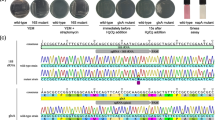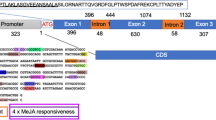Abstract
Blackspot, caused by the Ascomycete fungus Diplocarpon rosae, is the most widespread and pernicious disease of cultivated roses. While some species of rose possess resistance to D. rosae, none of the modern-day rose cultivars are fully resistant to the pathogen. In the current study, Biolistic gene delivery was used to introduce a rice gene, encoding a basic (Class I), chitinase into embryogenic callus of the blackspot-susceptible rose (Rosa hybrida L.) cv. Glad Tidings. The plasmid used for transformation carried the neomycin phosphotransferase (nptII) gene facilitating the selection and regeneration of transgenic plants on medium containing 250 mg/l kanamycin. Southern analysis confirmed integration of 2–6 copies of the chitinase gene into the rose genome; gene expression was confirmed by enzyme assay. Bioassays demonstrated that expression of the chitinase transgene reduced the severity of blackspot development by 13–43%. This degree of resistance to the pathogen correlated with the level of chitinase expression in the transgenic rose plants. The introduction of disease defence genes into rose provides a method of producing blackspot-resistant rose cultivars sought by breeders and growers.
Similar content being viewed by others
References
Arlorio M, Ludwig A, Boller T, Bonfante P: Inhibition of fungal growth by plant chitinases and β-1,3glucanases. Protoplasma 171: 34–43 (1992).
Austin D: The Heritage of the Rose. Antique Collectors Ltd, UK (1988).
Boller T: Biochemical analysis of chitinases and β-1,3glucanases. In: Gurr SJ, McPherson MJ, Bowles DJ (eds) Molecular Plant Pathology: A Practical Approach, pp 23–30. Oxford University Press, UK (1992).
Broglie K, Chet I, Holliday M, Cressma R, Biddle P, Knowlton S, Mauvais CJ, Broglie R: Transgenic plants with enhanced resistance to the fungal pathogen Rhizoctonia solani. Science 254: 1194–1197 (1991).
Firoozabady E, Moy Y, Courtney-Gutterson N, Robinson K: Regeneration of transgenic rose (Rosa hybrida) plants from embryogenic tissue. Bio/technology 12: 609–613 (1994).
Jefferson RA, Kavanagh TA, Bevan MW: GUS fusions: β-glucuronidase as a sensitive and versatile gene fusion marker in higher plants. EMBO J 6: 3901–3907 (1987).
Kikkert JR: The Biolistic PDS1000/He device. Plant Cell Tiss Org Cult 33: 221–226 (1993).
Knight C, Wheeler BEJ: Evaluating the resistance of roses to blackspot. Phytopath Z 91: 218–229 (1978).
Kuklinski JJ: Development of Diplocarpon rosae in leaves of roses differing in their susceptibility. Ph.D thesis, University of London (1980).
Lamb CJ, Lawton MA, Dron M, Dixon RA: Signals and transduction mechanisms for activation of plant defenses against microbial attack. Cell 56: 215–224 (1989).
Lin W, Anuratha CS, Datta K, Potrykus I, Muthukrishnan S, Datta SK: Genetic engineering of rice for resistance to sheath blight. Bio/Technology 13: 686–691 (1995).
Linthorst HJM: Pathogenesis-related proteins of plants. Crit Rev Plant Sci 10: 123–150 (1991).
Lion T, Haas OA: Nonradioactive labelling of probe with digoxigenin by polymerase chain reaction. Anal Biochem 188: 335–337 (1990).
Marchant R, Davey MR, Lucas JA, Power JB: Somatic embryogenesis and plant regeneration in Floribunda rose (Rosa hybrida L.) cvs. Trumpeter and Glad Tidings. Plant Sci 120: 95–105 (1996).
Mauch F, Mauch-Mani B, Boller T: Antifungal hydrolases in pea tissue. II. Inhibition of fungal growth by combinations of chitinase and β-1,3glucanase. Plant Physiol 88: 936–942 (1988).
McCabe MM, Power JB, de Laat AMM, Davey MR: Detection of single copy genes in DNA from transgenic plants by non-radioactive Southern blot analysis. Mol Biotechnol 7: 79–84 (1997).
Molano J, Duran A, Cabib E: A rapid and sensitive assay for chitinase using tritiated chitin. Anal Biochem 83: 648–656 (1977).
Pawlowski WP, Somers DA: Transgene inheritance in plants genetically engineered by microprojectile bombardment. Mol Biotechnol 6: 17–30 (1996).
Smith IM, Dunez J, Phillips DH, Lelliott RA, Archer SA: European Handbook of Plant Diseases. Blackwell Scientific, Oxford, UK (1988).
Salm TPM van der, Toorn CJG van der, Bouwer R, Hänish ten Cate CH, Dons HJM: Production of ROL gene transformed plants of Rosa hybrida L. and characterisation of their rooting ability. Mol Breed 3: 39–47 (1997).
Zhu Q, Lamb CJ: Isolation and characterisation of a rice gene encoding a basic chitinase. Mol Gen Genet 226: 289–296 (1991).
Zhu Q, Maher EA, Masoud S, Dixon RA., Lamb CJ: Enhanced protection against fungal attack by constitutive co-expression of chitinase and glucanase genes in transgenic tobacco. Bio/technology 12: 807–812 (1994).
Zikakis JP: Chitin, Chitinosan and Related Enzymes. Academic Press, New York (1984).
Author information
Authors and Affiliations
Rights and permissions
About this article
Cite this article
Marchant, R., Davey, M.R., Lucas, J.A. et al. Expression of a chitinase transgene in rose (Rosa hybrida L.) reduces development of blackspot disease (Diplocarpon rosae Wolf). Molecular Breeding 4, 187–194 (1998). https://doi.org/10.1023/A:1009642707505
Issue Date:
DOI: https://doi.org/10.1023/A:1009642707505




